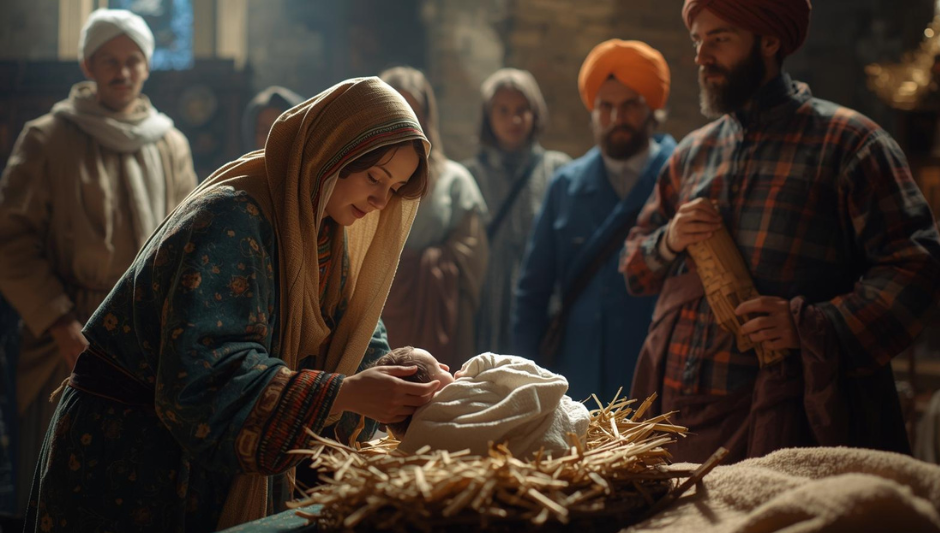How to Create a Christmas Nativity Scene That Inspires Wonder
Every year, churches and families around the world recreate the scene that changed everything: a manger, a mother, a newborn child, and the light of heaven breaking into an ordinary night. The Christmas Nativity scene is more than décor. It’s devotion.

Every year, churches and families around the world recreate the scene that changed everything: a manger, a mother, a newborn child, and the light of heaven breaking into an ordinary night. The Christmas Nativity scene is more than décor. It’s devotion.
St. Francis of Assisi staged the first Nativity in 1223 so that villagers could experience the Gospel not just in words, but in sight and sound. That impulse remains true today. A well-loved Nativity slows us down, invites reflection, and draws even the youngest parishioners into the story of the Incarnation.
Choosing Where the Story Lives
Location shapes the experience. A Nativity tucked near the altar creates a sacred stillness; one displayed outside the church invites the whole neighborhood to encounter it.
If you’re planning a Christmas Nativity scene outdoors, choose a spot visible from the street but sheltered from wind and rain. Add soft lighting—warm white strands or a single star-shaped lantern—to make the manger glow after dark. Indoors, think about how parishioners move through the space. The goal is to create a place where people can pause and pray, not simply pass by.
Gathering the Holy Family (and the Helpers Who Make It Happen)
The figures tell the story: Mary and Joseph centered around the Christ Child, the shepherds on the edge of wonder, the Magi on their way. Before Advent begins, check each piece for wear and repair what’s needed. A chipped halo or faded robe is easily fixed and keeps long-cherished sets looking new.
For new displays, simplicity wins. Choose durable materials—resin or wood for outside, ceramic or plaster for inside—and ensure the Holy Family remains the focal point. Invite the whole parish to a “Preparing the Way” decorating afternoon. Families can place figures, youth groups can hang lights, and maintenance crews can handle the heavy lifting. The beauty of preparing a Christmas Nativity scene together is that it transforms setup into fellowship. It fills the church with the joy of shared anticipation.
Making It Meaningful Through Detail
Small touches bring the scene to life. A scattering of straw under the manger. A plaque with Luke 2:10–11. Poinsettias donated in memory of loved ones. These choices turn decoration into prayer.
Some parishes add sound—a soft recording of carols or the parish choir practicing “Silent Night.” Others include a candle rack or prayer cards nearby so visitors can linger. The details aren’t about embellishment; they’re about invitation.
Blessing the Scene and the People Who Built It
Once the display is complete, gather the volunteers, the children, and anyone passing by for a short blessing. A deacon or pastor can lead a prayer, sprinkle holy water, and remind everyone that the Nativity scene is not just art, but testimony: “The Word became flesh and dwelt among us.”
Encourage families to bring their own small Nativity figures from home for blessing that same day. It’s a simple way to connect parish tradition with home faith life—and to celebrate the volunteers whose quiet work made it possible.
Let the Story Unfold Through the Season
The Nativity story doesn’t end on December 25. Keep your Christmas Nativity Scene in place through Epiphany. Add the Wise Men closer to January 6, symbolizing their journey to the Christ Child.
Leaving the display up through the full season honors the rhythm of the liturgical calendar—and gives parishioners a few extra weeks to stop, reflect, and remember that the miracle didn’t vanish with the wrapping paper.
When It’s Time to Pack Away the Manger
When the season closes, store the figures with the same care you used to display them. Wrap each one gently, label the boxes, and note any repairs for next year. But don’t rush the process. Take a final moment in front of the empty stable to say a quiet thank-you. Setting up and taking down the Nativity both become acts of faith: one in preparation, one in remembrance.
The Light That Remains
A Christmas Nativity Scene doesn’t compete with the busyness of December—it redeems it. It centers everything around the simple truth that God chose to arrive in the humblest way possible.
Whether your Nativity is carved from wood or made of plastic figures placed by children, it preaches the same sermon: holiness can begin anywhere. And when a parish builds it together—coordinated, prayerful, and united—the light of that holy night shines even brighter.
Ready to get started?
Make your 2025 holiday events the easiest and most impactful yet

